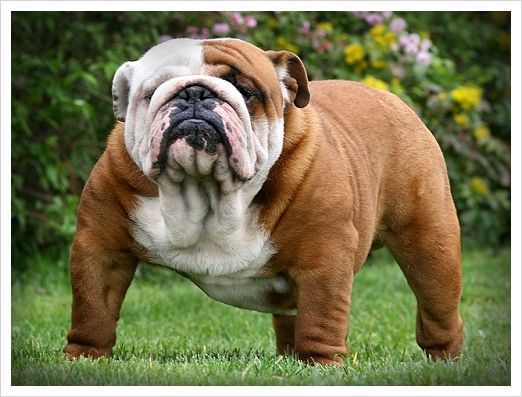English Bulldog
The English Bulldog is a dog of incomparable appearance. Robust and low, it has a fierce appearance (due to its origins), although its character is generally affectionate and peaceful. They are ideal for families where special attention is paid to pets, as it is a dog that needs to be in constant contact with its owners.
- In addition.
- Dogs of this breed are considered very loyal because it is very difficult to change owners.
- But they are also characterized by being quite possessive with food or toys.
- So if you want to adopt one of these dogs.
- In Animal Expert we will show you their main characteristics to get to know you better.
The English Bulldog has its origins in the bull-baiting that took place in Britain, and the purpose of this dog was to attack, infuriate and catch the bull. These habits resulted in dog fights with bulls and other large animals, but fortunately this cruel sport was banned in the 19th century.
When aerial bullfights were banned, the Bulldog lost popularity among the English and gradually disappeared. Some English immigrants living in the United States maintained the race with little change, giving birth to the ancestors of the American bulldogs. However, in England, the original Bulldog has crossed paths with smaller, less aggressive dogs, changing their shape to the one it currently has.
Today’s English Bulldog is not an aggressive dog capable of handling bulls, but an animal that, despite its fierce appearance, is a companion. Its current size and morphology do not allow it to do intense work and, its affectionate character has earned it the position of pet in thousands of homes where it is one more member of the family.
The breed standard does not indicate a predetermined size, but the Bulldog usually has a height at the crossing of about 40 centimeters. The weight, which is indicated in the norm, is about 25 kilos for men and 23 kilos for women.
It is a dog of heavy structure, small size and short hair. At first glance, you can see that it is a large, powerful and compact animal. The Bulldog’s head is large in relation to its body and has subtle wrinkles on the forehead and cheeks. The stop is deep and wide. The neck, thick and strong, has a large jowl. The face of the English Bulldog is undoubtedly its most distinctive feature. It is short and has a wide snout that tilts upwards with evident prognathism. In theory, this morphology helps the dog bite without releasing its prey, but it is unlikely to be so and, in fact, is not a common morphology in natural predators. In any case, the myth is still present. The round and medium eyes are well separated from each other and are very dark, almost black. They are not outstanding or low-profile. In turn, the ears are tall, small, thin and rose-shaped. The english Bulldog’s lips hang from the sides, but not from the front. The nose is broad and black. The jaws are wide, very strong and square, and the lower jaw is in front of the upper jaw and upwards.
The low, well-formed body should not show a tendency to obesity. The posterior region is high and strong, but significantly clearer than the previous region, which is very robust. The breast is wide, round and deep, and continues on a retracted abdomen. The ends are strong, muscular and robust. Females are less developed than males. The upper line forms a smooth arc, the spine being taller than the cross. The tail, low insertion, is medium to short length, thick at the base and finished in fine tip. The Bulldog usually takes it low and never wears it above the top line.
The thin, short and smooth fur of these dogs can be solid color (the whole body of the same color) or present more colors, in which the body has the same color but with part of the snout of another color. This dog can have the following colors: tawny and white, bringé and white, red, red and white, tawny and gray brought.
Also very characteristic is the movement of the English Bulldog, being heavy, with short and fast steps at the tip of the fingers, the hind legs rise, seeming to throw to the ground, according to the standard of the breed, no part of the body of the Bulldog should be oversized in relation to the others, thus breaking the general symmetry, giving the dog a distorted appearance or interfering with its ability to move with its ability to move , but this is debatable.Although the English Bulldog is a morphologically symmetrical dog, its structure can be considered by many to be deformed and can affect the ability to move to a certain extent.
The Bulldog is a determined dog, strong, alert, brave and faithful.According to the breed standard, it must also be an active animal, but adult Bulldogs are generally quiet.This dog needs a lot of attention and is not an animal that should be left alone for long periods of time.It forms close ties with his human family and it is difficult (but not impossible) to change ownership.
His fierce appearance often gives a bad impression. These dogs tend to have a friendly, quiet and peaceful character, although they are also stubborn when they want something.They are usually very patient with children and are generally excellent pets, but they are not very active Dogs The character varies according to the dog and also depends on the conditions in which the dog lived or lived.
When the Bulldog gets angry, it’s an animal to be feared.By defending his territory, his family or his belongings, he is an angry dog and capable of causing a lot of damage.Therefore, it is very important to socialize him from puppy and educate him about good manners and canine obedience.One of the aspects that can trigger Bulldog’s aggression is competition for food and toys.These dogs tend to be possessive, so you should avoid becoming resource guardians.The training of obedience and, above all, self-control exercises contribute a lot to this.In turn, this function can be used to make the English Bulldog a good home caregiver.By not compulsively barking, this dog can sound the alarm when it is really needed, and its appearance can frighten many people.However, its same physical structure makes it not an ideal protective dog.
In adulthood, Bulldogs can be aggressive with other dogs, especially the same sex and other animals. However, when you have properly socialized, you can get along with other dogs and pets. In any case, many owners of this breed prefer to sterilize their dogs to minimize the risk of fighting.
Heat is a health risk of the English Bulldog. The extremely flat face has an effect on the dog’s airways and makes it difficult to breathe when the Bulldog is agitated and therefore when it is very hot. It’s good for the Bulldog to exercise moderately to stay in shape, but being sure that exercise can be a risk factor, especially in warm climates. You should never leave a Bulldog or any other dog in a closed car, due to the risk of thermal shock. This is not a dog for intense exercise. You won’t win a agility championship with your English Bulldog, unless only dogs of this breed compete. But you need daily walks to exercise and socialize with people and other dogs. On the other hand, the Bulldog is not a dog to live in the garden, it does not support climatic variations, so it must live indoors. In addition, his great need for companionship makes him unable to live in the garden. The good news is that it is a dog cleaner than other breeds and is not very active. The bad news is you can drool a lot.
These dogs lose their fur regularly, so you have to brush it frequently, but their fur is easy to maintain, usually it is enough to brush it two or three times a week, in addition, you should clean the wrinkles that form on the face, neck and tail with a soft, damp cloth or a soft, moist sponge , then dry with a soft, dry cloth.
The English Bulldog learns easily when trained with positive methods, such as clicker training; However, when canine training is based on traditional techniques and dominance theory, many conflicts are created and the dog does not react well.I can’t expect the Bulldog to respond as quickly as a more athletic dog would (a Boxer or a Belgian Malinois, for example).
Due to the intense and poorly planned artificial selection to which it has undergone, this breed has many inherited diseases and other health problems. Common diseases in English Bulldogs include hip and elbow dysplasia, respiratory problems, karates, keratoconjunctivitis, entropion, elongated palate, inverted tail, skin problems and gastric torsion. Therefore, they may also have other diseases of the dog, depending on the care that each animal receives and its particular genotype.
A relatively common problem, stemming from the flattened face of the English Bulldog is shortness of breath.Exaggerated facial shortening has caused many current Bulldogs to have breathing problems.
On the other hand, the difference in mass between females and males, added to the fact that the back of the body is light while the front is heavy, makes it difficult for these dogs to reproduce. Human assistance is generally required both during crossing and during delivery.

